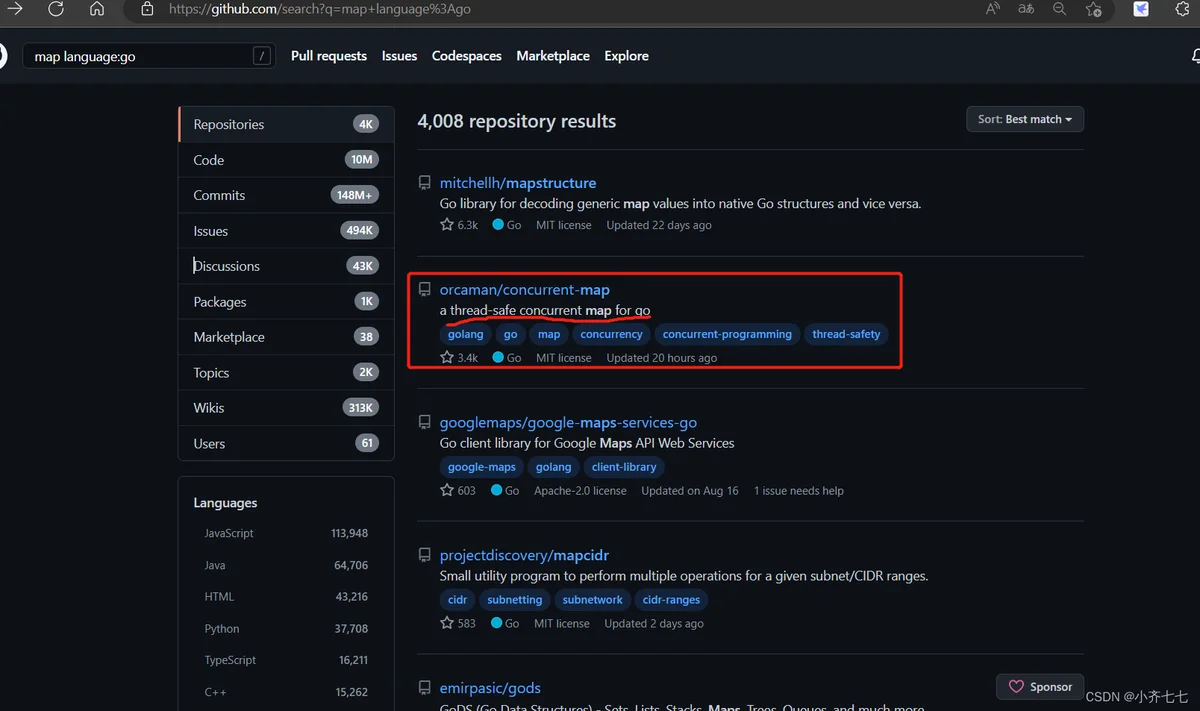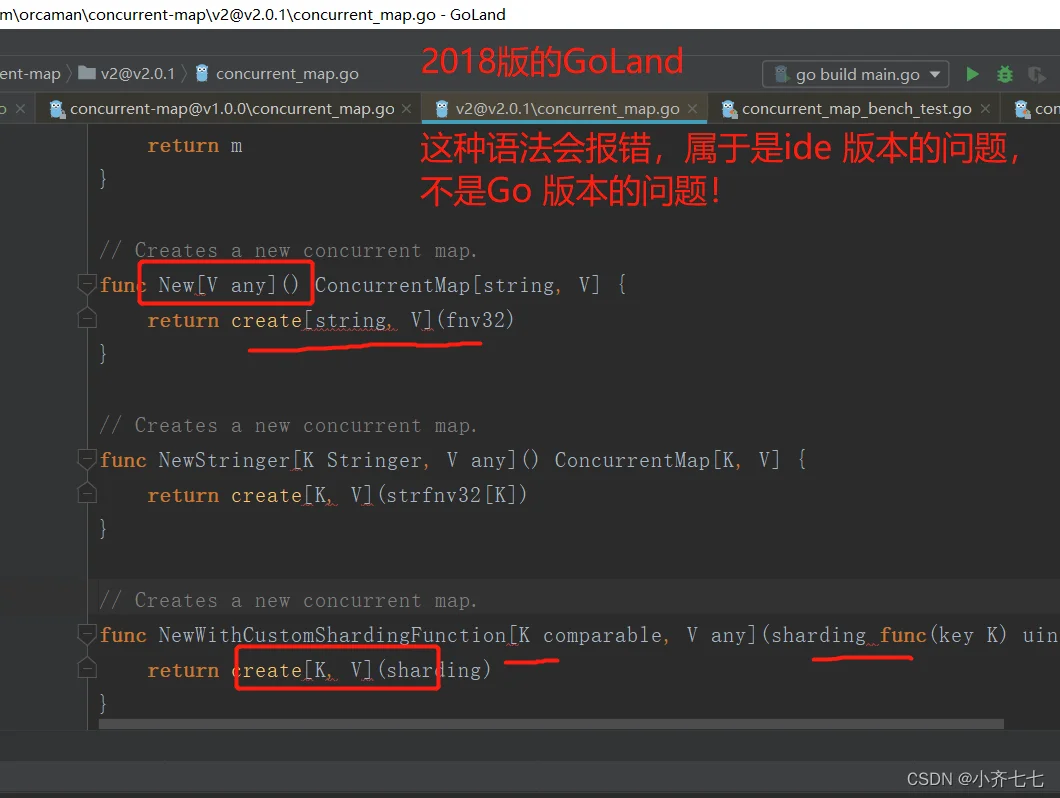1. 加锁
对整个map加上读写锁sync.RWMutex
//keyType为key的类型,valueType为value的类型
type RWMap struct {
Map map[keyType]valueType
sync.RWMutex
}
func NewRWMap(capacity int) *RWMap {
if capacity < 0 {
capacity = 0
}
return &RWMap{
Map: make(map[keyType]valueType, capacity),
}
}
//add or update
func (m *RWMap) Set(key keyType, value valueType) {
m.Lock()
defer m.Unlock()
m.Map[key] = value
}
//delete
func (m *RWMap) Delete(key int) {
m.Lock()
defer m.Unlock()
delete(m.Map, key)
}
//get
func (m *RWMap) Get(key int) valueType {
m.RLock()
defer m.RUnlock()
return m.Map[key]
}
优点:解决了问题。
缺点:锁粒度大。
2. 分片加锁
一个操作会导致整个map被锁住,导致性能降低。所以提出了分片思想,将一个map分成几个片,按片加锁。
第三方包实现:github.com/orcaman/concurrent-map
github上用 map language:go 搜索:

3.4kstar
插曲:注意,如果你的goland ide 版本太老的话,github.com/orcaman/concurrent-map/v2 版本是用不了的:

所以我最后换成VSCode,发现就没这个问题了。(因为新版本的GoLand还得继续想法子破解)
源码New方法返回的map,看到key只支持string
// Creates a new concurrent map.
func New[V any]() ConcurrentMap[string, V] {
return create[string, V](fnv32)
}
Example and usage
package main
import (
"fmt"
"time"
cmap "github.com/orcaman/concurrent-map/v2"
)
func main() {
m := cmap.New[int]()
for i := 0; i < 300; i++ {
go func(i int) {
m.Set(fmt.Sprintf("%v", i), i*2) //并发写
}(i)
}
time.Sleep(4 * time.Second)
fmt.Println(len(m.Keys()))
}
execute and output:
PS C:\GoWork\src\asset-manager\mytest> go run main.go
300
并发写没问题。
更多使用示例包里的concurrent_map_test.go里面提供了。
3. sync.Map
标准库中的 sync.Map是专为 append-only 场景设计的。
sync.Map在读多写少性能比较好,否则并发性能很差。
Go源码:
// Map is like a Go map[interface{}]interface{} but is safe for concurrent use
// by multiple goroutines without additional locking or coordination.
// Loads, stores, and deletes run in amortized constant time.
//=====自注释======
sync.Map 很像Go map[interface{}]interface{}。但sync.Map是线程安全的,能被多个协程在没有额外的锁或者协调的情况下并发使用。
Loads,stores,deletes操作都运行在分摊常数时间内。
amortized 平摊的(adj.)英 /əˈmɔːtaɪzd/
//=====自注释======
//
// The Map type is specialized. Most code should use a plain Go map instead,
// with separate locking or coordination, for better type safety and to make it
// easier to maintain other invariants along with the map content.
//=====自注释======
invariants (n.) 不变量(invariant的复数)/ɪnˈveriənts/
sync.Map 类型是为特殊情况专门设计的。
大多数代码都应该使用普通的Go map + 单独的锁或者协调 ,这种形式,来获得更好的类型安全
以及使得在维护映射内容的同时维护其他不变量更容易。
//=====自注释======
//
// The Map type is optimized for two common use cases: (1) when the entry for a given
// key is only ever written once but read many times, as in caches that only grow,
// or (2) when multiple goroutines read, write, and overwrite entries for disjoint
// sets of keys. In these two cases, use of a Map may significantly reduce lock
// contention compared to a Go map paired with a separate Mutex or RWMutex.
//=====自注释======
disjoint (adj.) 不连贯的,(两个集合)不相交的 /dɪsˈdʒɔɪnt/
sync.Map类型针对两个常见用例进行了优化:
(1)对于一个给定的key,只会写一次,但是读很多次,就像在只增长的缓存中一样。
(2)当多个协程读,写,重写不相交的keys。
以上两种情况,相比于使用Go map + Mutex(或者RWMutex),使用sync.Map能显著减少锁竞争。
//=====自注释======
//
// The zero Map is empty and ready for use. A Map must not be copied after first use.
type Map struct {
mu Mutex
// read contains the portion of the map's contents that are safe for
// concurrent access (with or without mu held).
//
// The read field itself is always safe to load, but must only be stored with
// mu held.
//
// Entries stored in read may be updated concurrently without mu, but updating
// a previously-expunged entry requires that the entry be copied to the dirty
// map and unexpunged with mu held.
read atomic.Value // readOnly
// dirty contains the portion of the map's contents that require mu to be
// held. To ensure that the dirty map can be promoted to the read map quickly,
// it also includes all of the non-expunged entries in the read map.
//=====自注释======
expunged (adj.)/ɪkˈspʌndʒ/ 被擦去的,被删掉的
dirty map 包含map内容的部分,该部分要求持有mu锁。为了确保dirty map能快速提升到read map,
它还包括read map 中所有未删除的项。
//=====自注释======
//
// Expunged entries are not stored in the dirty map. An expunged entry in the
// clean map must be unexpunged and added to the dirty map before a new value
// can be stored to it.
//
// If the dirty map is nil, the next write to the map will initialize it by
// making a shallow copy of the clean map, omitting stale entries.
dirty map[any]*entry
// misses counts the number of loads since the read map was last updated that
// needed to lock mu to determine whether the key was present.
//
// Once enough misses have occurred to cover the cost of copying the dirty
// map, the dirty map will be promoted to the read map (in the unamended
// state) and the next store to the map will make a new dirty copy.
misses int
}
read atomic.Value
sync/stomic包里都是go提供的原子操作。
sync.Map思想:就是用两个数据结构(只读的 read 和可写的 dirty)尽量将读写操作分开,并最小粒度加锁,来减少锁对性能的影响。
总结
较常使用的是前两种:加读写锁和分片加锁。特定场景下sync.Map性能会有更优的表现(要满足那两个场景条件比较苛刻,实际很少用)。
